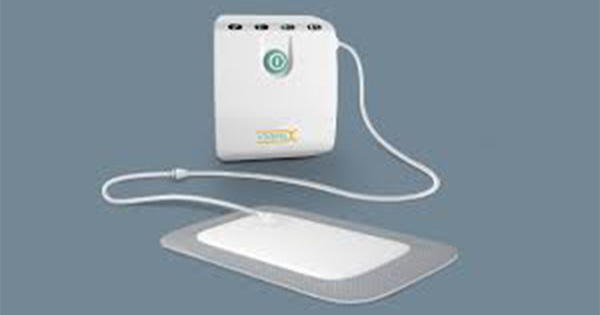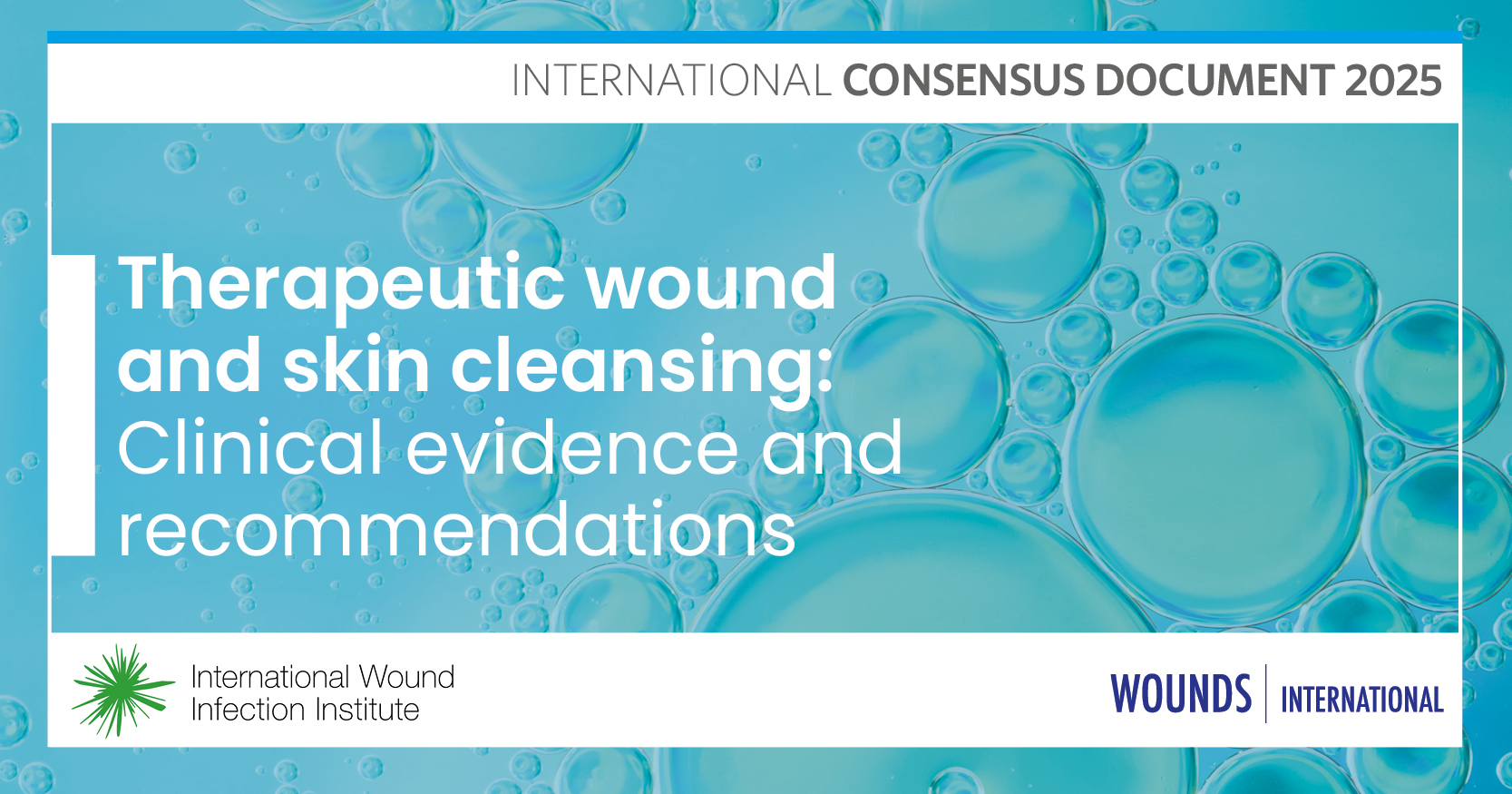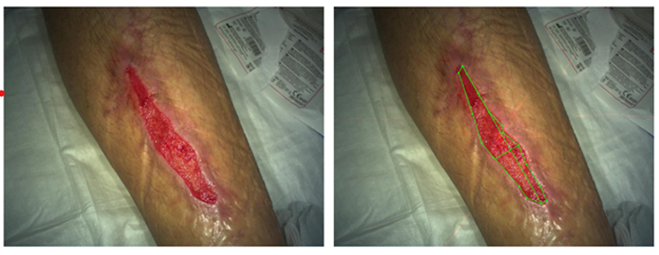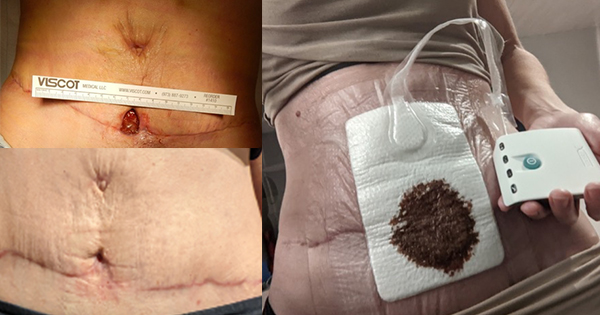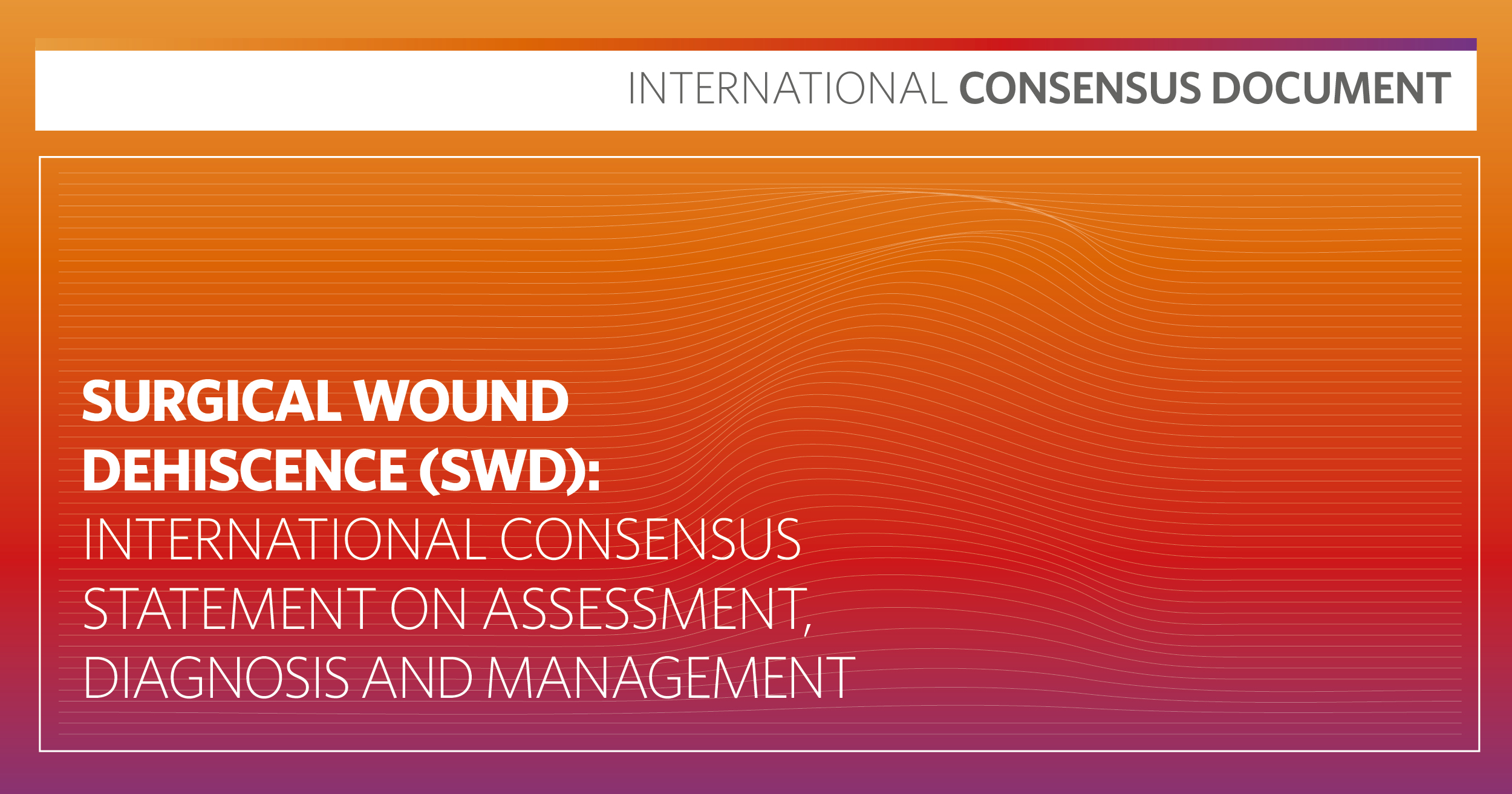Introduced into clinical practice in the early 1990s, negative pressure wounds therapy (NPWT) has become a staple in both the inpatient and outpatient setting in the management of complex wounds (Bobkiewicz et al, 2014) [Box 1]. Historically, NPWT has been used to manage different acute and chronic wounds, for example, open fasciotomy wounds and diabetic foot ulcers. NPWT is also effective in the management of postoperative surgical incision wounds (as closed incision NPWT; ciNPWT) in a variety of specialties and therapeutic methods. It has been found to be proficient in reducing oedema and seroma formation, and preventing surgical dehiscence in high-risk incision sites, as well as promoting granulation to encourage wound healing (Zaver and Kankanalu, 2022).
Prophylactic use of NPWT reduces the incidence of postoperative complications (infection, dehiscence, delayed wound healing) in breast surgery (Galiano et al, 2018; Johnson et al, 2021; El Hawa et al, 2022) and have better cost-effectiveness when compared to standard dressings (Liew et al, 2022).
NPWT can improve the survival rate and reduce the infection rate of split-thickness skin grafts (Ran et al, 2021). Application of vacuum-assisted closure normalises the stress distributions around the closed incision in skin by up to 50%, which relates to a reduction of the probability of dehiscence, poor cosmesis and scarring (Wilkes et al, 2012; Loveluck et al, 2016).
NPWT can be used on primary closure surgical sites to reduce risk of surgical site complications, such as infection, seroma, haematoma, local skin ischaemia and necrosis, dehiscence and delayed healing (Banasiewicz et al, 2019).
The complementary use of traditional NPWT and sNPWT has been highlighted in the literature (World Union of Wound Healing Societies [WUWHS], 2018), especially for wounds in the final healing phase as sNPWT can be used for up to 7 days (Banasiewicz et al, 2019). Figure 1 is adapted from the WUWHS (2019) consensus document on ‘Wound exudate, effective assessment and management’ and was first published in 2019 (Wounds International, 2019). Wound type is a more important factor than surgery type when considering when and which form of NPWT is appropriate, but the choice between traditional and sNPWT depends on the individual patient, the clinician’s experience and local protocols. NPWT has been found to be particularly suitable for highly exuding, deep or complex dehisced wounds and it has been “suggested as a gold standard treatment” for open abdominal wounds and dehisced sternal wounds (European Wound Management Association, 2017).
Optimising patient quality of life (QoL) should always be a key consideration in clinical-decision making — for some patients, the switch to sNPWT may be suitable for outpatient treatment and for individuals who require earlier mobilisation and discharge from hospital (WUWHS, 2016).
Aims of the expert panel
An international expert panel of surgical specialities assembled on 18 October, 2023 in Barcelona, chaired by Professor Dr Tomasz Banasiewicz. They shared their extensive level of using experience of NPWT, identifying the indications and advantages of single-use NPWT (sNPWT) and traditional NPWT usage, respectively. The development of single-use NPWT is relatively recent and there remain a few question marks over when and where it is appropriate.
The aim of this meeting was to reach consensus of how to achieve the best clinical results using VivereX sNPWT alongside Vivano traditional NPWT to support the reduction of postoperative complications and further exacerbation of acute and chronic wounds.
Key considerations when choosing VivereX sNPWT
The main points of discussion represent a continuation of the previously outlined expert panel recommendation in 2019. The step-up step-down approach to selecting appropriate NPWT set the following key considerations when deciding whether or not to use sNPWT (Banasiewicz et al, 2019):
- Low/moderate exudate production (<100ml/24 hours)
- Low-density exudate
- Smaller wound
- No infection present.
- The clinical specialists agreed that a variety of factors should be taken into account when selecting an NPWT device for a patient with a wound [Table 1].
- The following main factors was considered during the round table:
Patient-related factors
- The experts also discussed the specific risk factors for individual patients.
- The group took to the floor to discuss higher-risk (‘problematic’) patients, particularly obese individuals and smokers.
- In addition to obesity, diabetes and cardiovascular conditions can be common problems as high-risk factors in experiencing surgical site infection (SSI).
- The age of the patient was added to the list, with the challenges to wound management associated with patients with dementia discussed.
- Furthermore, those who are malnourished and/or immunosuppressed were also identified as high-risk individuals.
Wound-related factors
- The level of exudate was highlighted as a key consideration in the clinical setting when selecting sNPWT — low exudate levels make sNPWT an ideal option in wound management, which is in line with the previous recommendation.
- A number of wound-related factors should be considered when selecting an NPWT device, including the type of surgery, the size of the wound, prevention of complications and exudate density
- Blood loss during surgery is a key factor when making any decisions on the type of NPWT to use and one that is not standardised at present. The clinical specialists concurred that high blood loss is certainly a risk factor and should be defined. For example, should it be 300ml and 500ml, 10-15% of circulating blood or 1.5 litres?
Indication related factors
- NPWT (Vivano) is the preferred system in orthopaedic trauma and plastic and reconstructive surgery, specifically used in the management of traumatic lesions and pressure ulcers
- The type of surgery plays an important role in determining the risk level that can be attached to an individual, such as if it is clean or contaminated. To avoid the costs associated with SSIs, prevention through NPWT is considered
- Prevention of seroma formation is a key consideration when carrying out reconstructive surgery
- SSI prevention is the most important factor that is considered when carrying out reconstructive surgery
- Proving the indication and cost-effectiveness of sNPWT were critical considerations in selection decision-making
- Laparotomy and Caesarean-section were also mentioned by the experts as situations where sNPWT would not be used.
The difficulty of making more universal indications for sNPWT was discussed by the panel. They suggested the use of an SSI risk index, such as the one presented by van Walraven and Musselman (2013). The clinical specialists stressed that usage of an SSI risk calculator coupled with the decisions of clinicians can be the preferred course of action.
The benefits of using sNPWT as a preventative approach (Closed Surgical Incision)
The global pooled incidence of SSI was found to be 2.5% (95% CI: 1.6, 3.7) in a study undertaken by Mengistu (2023), underlining the toll it takes on healthcare systems across the world. The preventative approach of using sNPWT was discussed by the panel and the benefits of SSI prevention were split into five sections — wound, skin, patient, staff and system.
The panel then went into detail on the sections; under the ‘wound’ sub-heading, reduction of seroma and haematoma formation, surgical site infection and reduced necrosis were discussed; the skin sub-heading outlined the importance of a reduction in dressing changes resulting in less irritation, a reduction in oedema and the fact that prevention of SSI is more gentle for skin. Quality of life (QoL) benefits were listed under the ‘patient’ sub-section as patients gained from improved mobility and higher levels of comfort. There was less work for clinicians, mentioned under the ‘staff’ heading, as well as a cleaner environment (including SSI surveillance in the operating room, decontaminated medical devices and surgical instruments; World Health Organization, 2018) and the ‘system’ benefitted from reduced length of patient stays in hospital and the attendant cost reductions.
The benefits of using sNPWT (VivereX) therapeutically in acute and chronic wounds
There are numerous benefits for using sNPWT in both acute and chronic wounds: the WUWHS consensus document on surgical wound dehiscence (WUWHS, 2018) cites the associated contraction of the wound edges that reduces wound size, fluid volume and oedema, as well as improved tissue perfusion.
VivereX’s ready-to-use wound dressing absorbs low to moderate exudate levels on a range of wound types, including (but not limited to) skin grafts and donor sites, chronic wounds (diabetic foot ulcers, pressure ulcers, leg ulcers), traumatic wounds, sub-acute dehisced wounds and burn injury grades I and II (data on file).
sNPWT (VivereX) device wear time
The current wear time of VivereX is recommended at 10 days. The expert group established that this wear time operates in tandem with the WUWHS’s advice that ciNPWT is used between 5 to 7 days (WUWHS, 2016). Based on their clinical practice (after 72 hours, the wound is sealed) they proposed the formalisation of changing the wound dressing on patient discharge.
Approaching a decision-making checklist
The majority of the panel believed that sNPWT can be a cost-effective way of managing and treating wounds but the need for robust data to prove this was paramount going forward. For instance, Professor Dr. Lenka Veverkova stated that there is a lack of data surrounding even how any people actually have an SSI in the Czech Republic. She shared a study conducted at her hospital that there was an increase in risk of infection of 1% each minute over 2 hours for those undergoing surgery.
Highlighting the cost to healthcare systems, it is estimated that 1.5 to 2 million people suffer from acute or chronic wounds, with approximately 15% of these wounds remaining unhealed after 1 year (Lindholm and Searle, 2016). In the UK alone, the estimated annual cost of wound management and associated comorbidities in 2017/2018 stood at £8.3 billion (Guest et al, 2020).
Indications of use for sNPWT
The clinical specialists of the expert panel initiate application of sNPWT in the emergency setting, specifically for very high-risk laparotomy wounds. They posited that sNPWT can be considered for individuals with pressure ulcers, those who were post-amputation as a preventative measure, and patients who had undergone a complicated amputation, as well as individuals having surgery for scoliosis.
Furthermore, they indicated the use of sNPWT in the following scenarios: amputation, traumatic wounds (where the skin has been crushed), after plastic surgery and post-graft.
The experts stated that if the aim of wound care is to support the granulation formation, they would not consider using sNPWT, but other than that, they would advocate for its use to prevent SSI. They declared they are open to using sNPWT after surgery.
It must be remembered that wound exudate (volume and density) is the main limitation of using sNPWT.
Case study presentations
The panel were invited to share case studies emphasising the effective use of VivereX in clinical practice. Figure 2 shows the summarised healing journey of a 65-year-old female who underwent a resection of the intestinal fistula with infected mesh. After the application of VivereX, this individual’s wound had no signs of infection or exudate, there were areas of granulation and epithelilisation, and the patient began using standard dressings.
Other case studies are presented in Figures 3–5, describing the use of sNPWT in the treatment of complications after extensive operations for breast cancer. Viverex was selected in these cases to prevent SSI, necrosis and dehiscence to achieve timely wound healing and positive cosmetic results.
Conclusion
It was agreed by the panel that data collection is absolutely key to support the use of sNPWT. This should cover the cost-effectiveness when considering the cost savings associated with its use in terms of sNPWT’s potential to release nursing hours and reduce intervention costs. VivereX is also a cost-effective way of offering NPWT to patients in outpatient settings.
A new generation of data surrounding patients’ QoL at a multinational level should be the aim, focusing on the individual’s return to work in a timely fashion and reducing the length if stay in hospital, thus proving to be a cost-effective option. The portable nature of the single-use system also makes it more gentle for skin and there is a reduction in the risk of skin stripping when using sNPWT.
Prophylactic use of NPWT on primary closure surgical sites is effective in reducing the incidence of surgical site infections (Groenen et al, 2023).
If there is a suspicion of higher exudate then traditional NPWT is recommended over sNPWT but the latter has clinical benefits for superficial, complicated wounds with low to moderate exudate levels. The general conclusion of the expert panel was that sNPWT has a range of preventative and therapeutic benefits that make it a key element of the clinician’s toolkit (Groenen et al, 2023).

